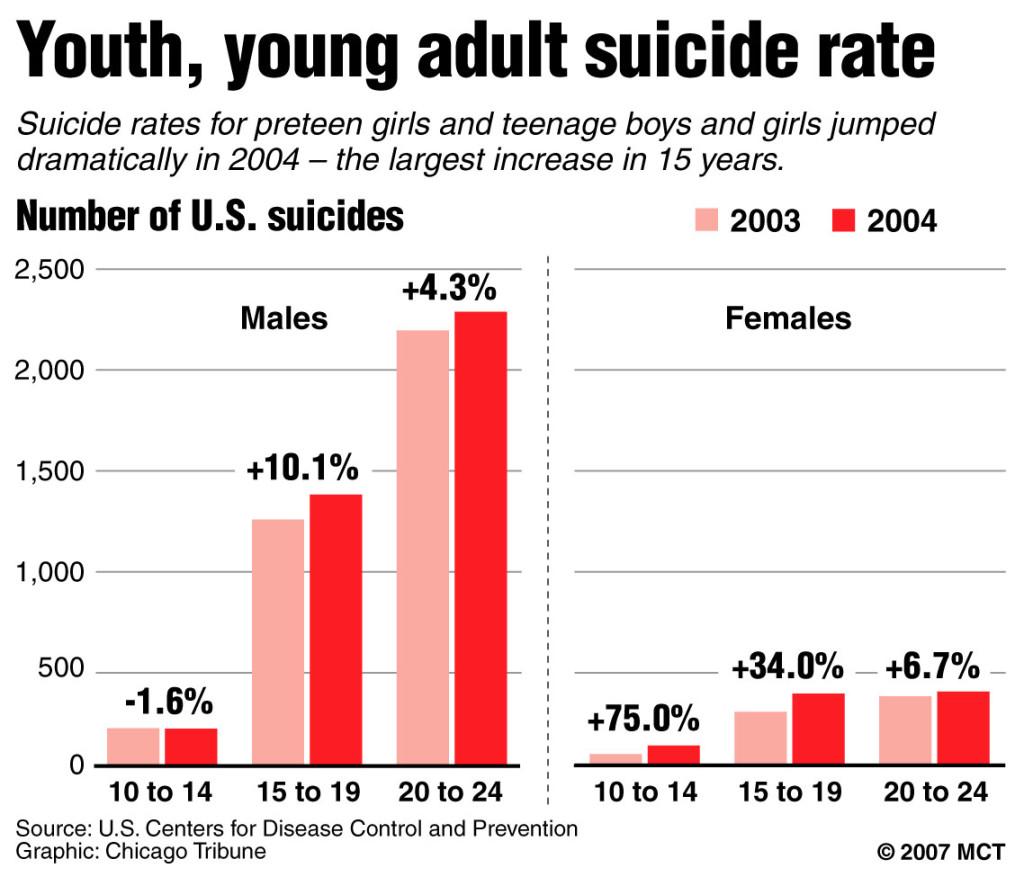Young Adult Suicides Increase Drastically
Photo by Photo from MCT Campus
Charts show the number of suicides among 10- to 24-year-olds in the U.S., with the rate of change between 2003 and 2004. Chicago Tribune 2007
February 12, 2014
Suicide is the “the deliberate taking of one’s own life, usually the result of a mental disorder although sometimes deliberated in the face of life-threatening physical illness, significant interpersonal stress, or when under the influence of one or more substances of abuse,” according to Salem Health Magill’s Medical Guide. Often, those who are suicidal tend to be going through things that they want to avoid, usually something emotional or physical that they think they can not bear.
“Suicide is a preventable tragedy that is strongly related to untreated mental health issues, specifically depression,” said Meridith Wirtz, BHS school adjustment counselor/social worker, “Suicidal ideation among young people can also be associated with substance issues and feelings of victimization or not belonging.”
Each year, there are about 500,000 self-inflicted injuries and 30,000 completed suicides. In Massachusetts alone, there were 553 completed suicides, 4,388 hospital discharges for self-inflicted injuries, and 6,346 emergency department visits for self-inflicted injuries in 2011, according to the Massachusetts Department of Public Health. In Newton, three high school students have committed suicide since the start of the school year, according to a recent Boston Globe article.
“Suicide rates in Massachusetts have increased over the past several years and the Cape and Islands rates are higher than the state average; especially among young people ages 15-24 and men ages 35-44,” said Wirtz.
Male suicides exceed females by almost four to one. Women attempt suicides more than men but men complete suicides more than women because they use more lethal means, such as a gun, according to MDPH.
Suicidal thoughts and impulses are often seen as symptoms of the underlying disorder and require treatment like any other disorder. Depression is the most common mental illness that causes suicide; suicidal thoughts are actually considered to be a symptom of clinical depression.
In order to prevent suicide and depression, BHS has a number of programs and activities, added Wirtz.
For the first two weeks of April, the Signs of Suicide program will be conducted with eighth graders, sophomores, and seniors. It’s the same program each year, which is why it’s not done yearly, said Alexis Tellert, House D guidance counselor.
The program will consist of psycho-educational information about depression, the signs of depression and suicide in others and in students themselves, and also how students can help one another, added Tellert.
For seniors, in particular, they will be learning how to deal with depression and stress after they no longer attend BHS.
“BHS has a strong system of student support which includes six school counselors, a full time social worker, two half-time adjustment counselors, three school psychologists, a supportive school nursing staff, and a very caring teaching staff and administration,” said Wirtz.
In addition to the Signs of Suicide program, BHS also promotes Challenge Day and Healthy Hallways to create safe environments and awareness of what goes on in the community.
Some things students can do to promote a healthy environment are to “say ‘hello’ to a person you don’t typically speak to, invite someone who usually sits alone in class or lunch to sit with you, speak up if you hear someone teasing someone else and most importantly, if you think someone is struggling, seek adult assistance,” added Wirtz.
In addition, in every house office there is an anonymous box where students can inform any guidance counselor about someone they may be concerned for.


